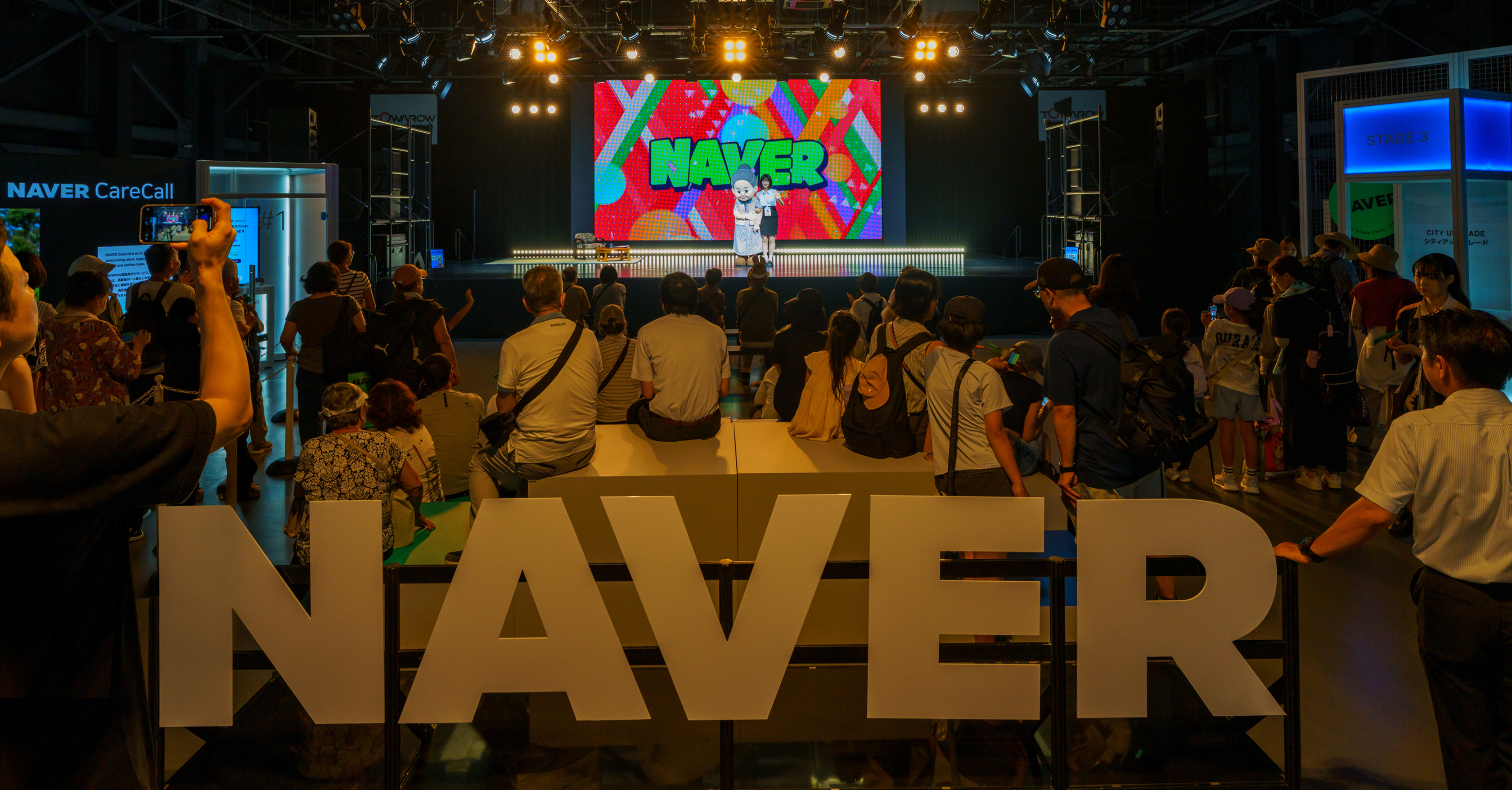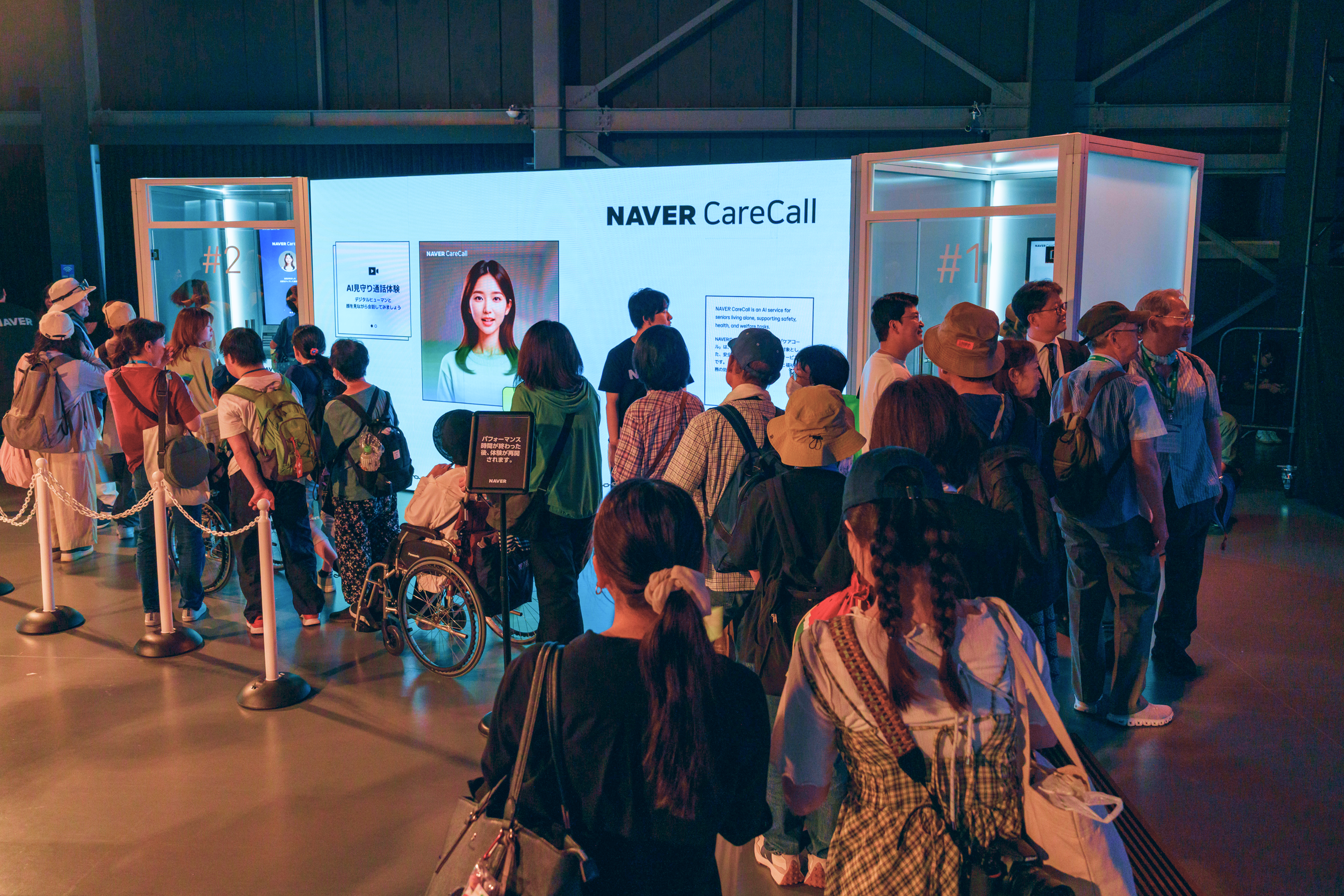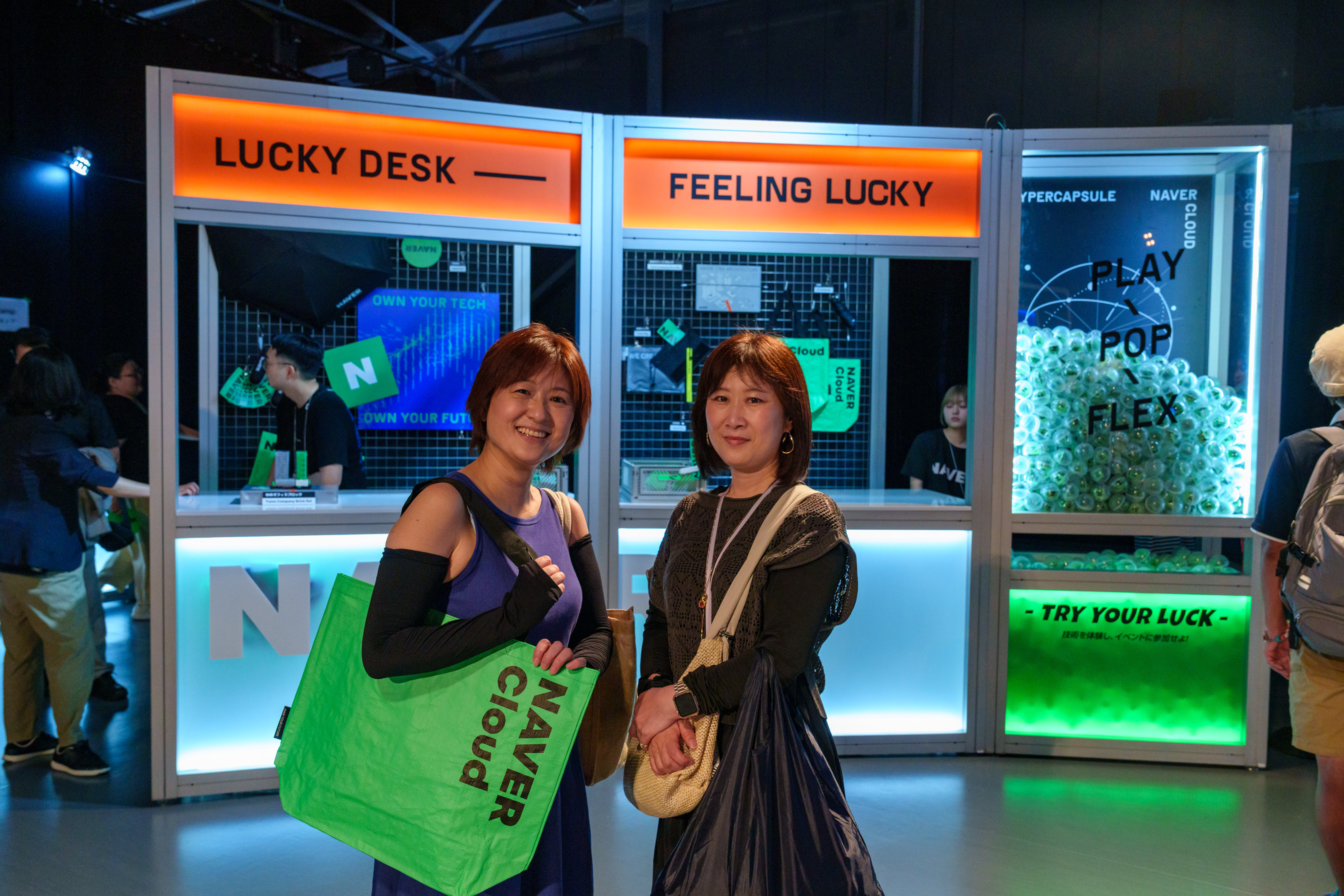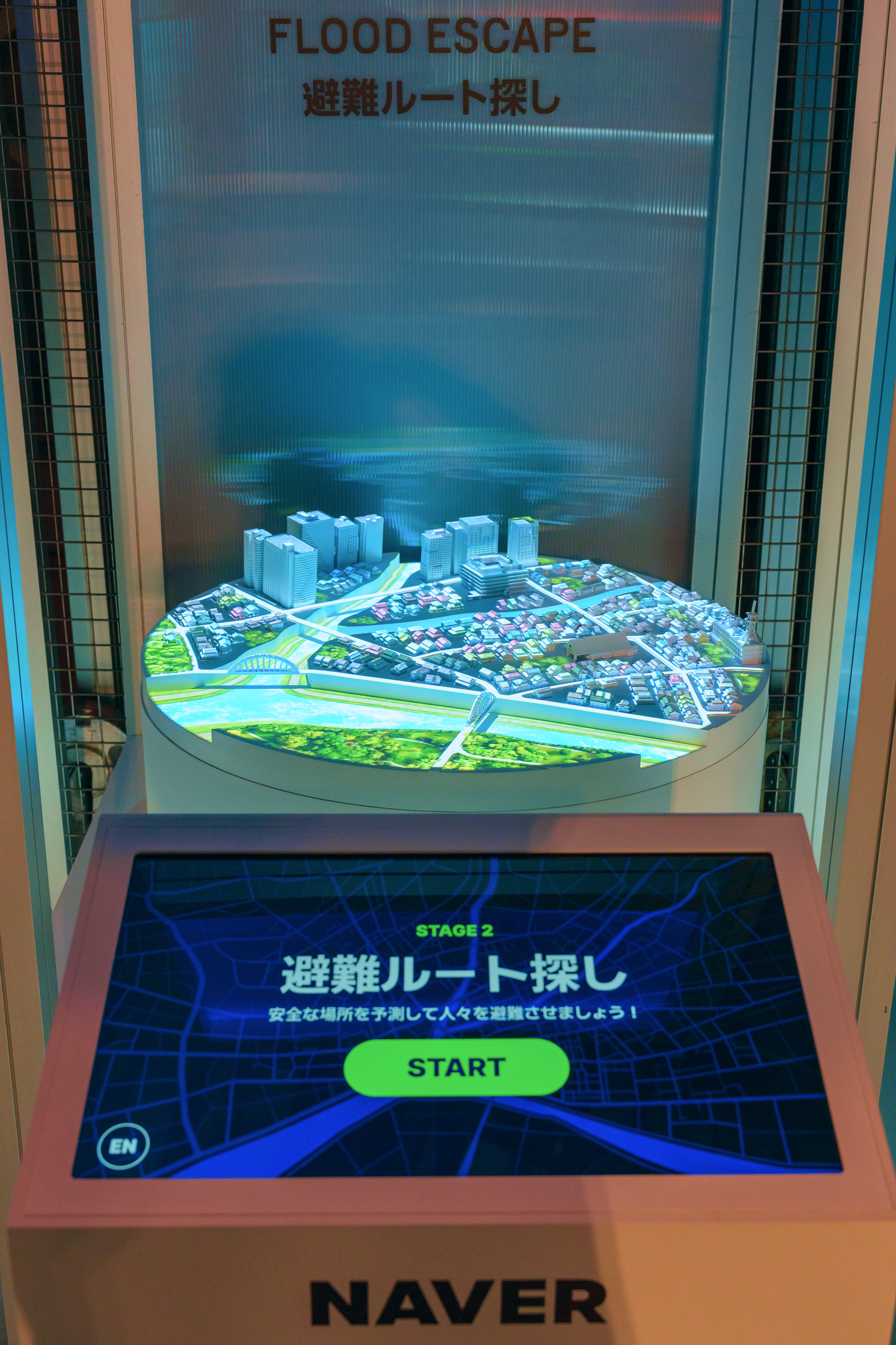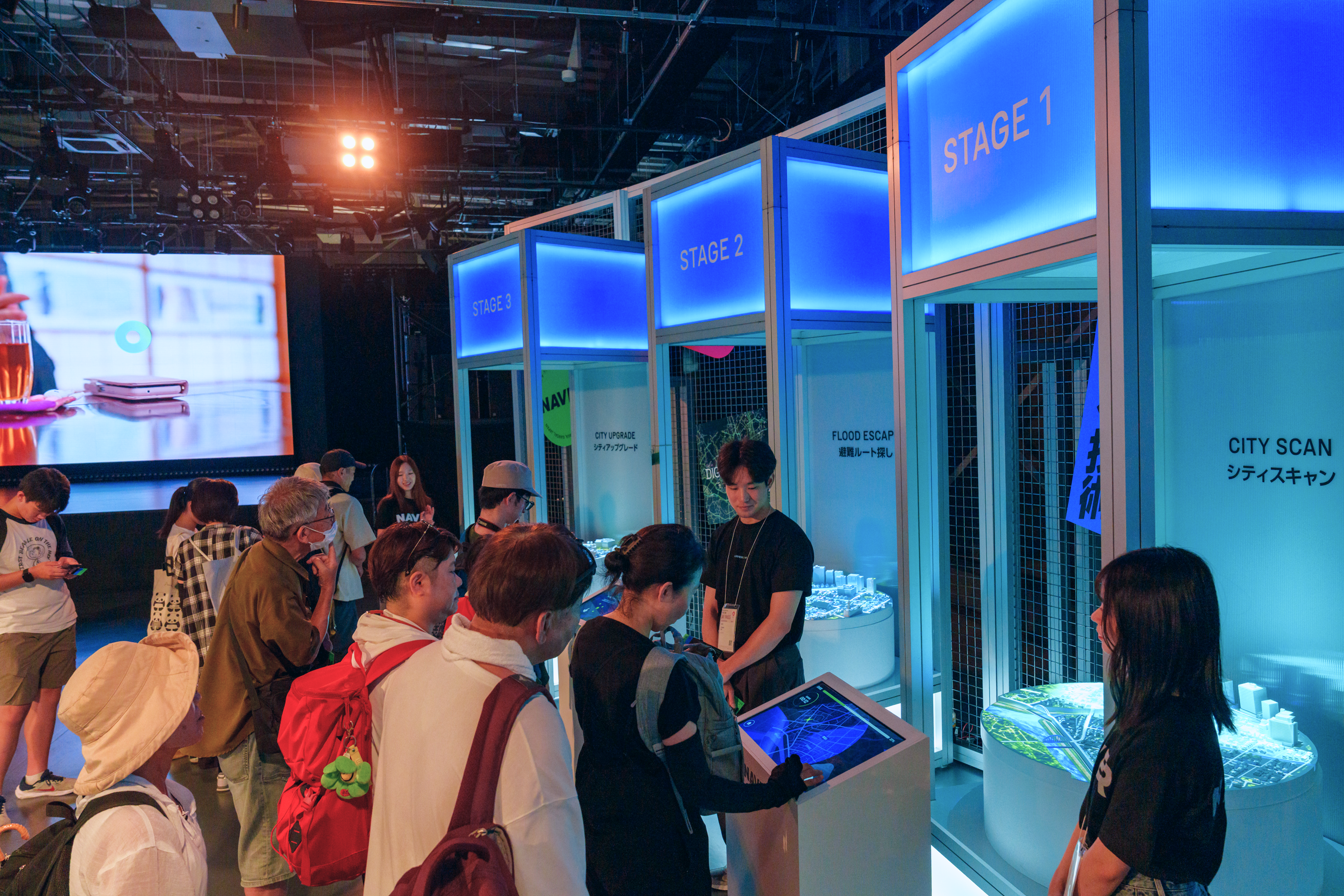When NAVER Cloud joined this year’s Expo in Osaka, we came with a simple but powerful idea: using technology to bring people and cities closer together and reimagining what urban life could look like.
Instead of just setting up displays about our CareCall and Digital Twin technologies, we wanted visitors to really understand how these innovations could make cities safer and more efficient. So we told a story through two characters—Yume, an AI researcher, and an older woman living by herself in a rural village. This approach helped people see how technology can care for people and transform communities. Through Yume’s eyes, visitors could imagine a future where AI creates safer, more connected communities.
Our Osaka Expo journey begins here.
CareCall: Technology for people
Checking on distant family members and providing safety and emotional support to elderly people living alone has become a shared global challenge. Older adults living independently face heightened risks from minor accidents and often experience emotional isolation that significantly impacts their quality of life.
CareCall was developed to address this growing need in our aging societies. This AI-powered service makes daily check-in calls that go beyond routine wellness checks. Through its conversational memory feature, CareCall remembers previous interactions and builds on them.
The AI might ask, “You mentioned yesterday that your knees were bothering you. How are they feeling today?” These thoughtful conversations provide emotional stability while serving as an early warning system for emergencies.
Real-world impact in Japan
We deployed CareCall in Izumo, Japan, where 35% of residents are elderly, to support older adults living alone. Our AI conducted daily check-ins, detecting subtle changes in voice patterns or responses and alerting human caregivers when intervention was needed.
The impact was significant: what previously required 100 staff members to check on 10,000 elderly residents now needs only 5 people. This efficiency freed care managers from repetitive tasks, allowing them to focus on providing deeper, more meaningful support to those who need it most.
You can learn more about how CareCall is transforming elderly care here.
Experiencing CareCall at Expo 2025
At the Osaka Expo, we created an interactive CareCall zone where visitors could experience the technology firsthand. Visitors answered calls from our AI and engaged in natural conversations that felt surprisingly personal. The AI didn’t just exchange pleasantries—it asked about emotions, offered empathy, and provided genuine warmth that many visitors described as “talking to a real person.”
Voices from the World Expo
Visitors who experienced CareCall at the expo had varied reactions. Some of the responses revealed how deeply this innovation resonated with real human needs.
One conversation particularly stood out—with a woman who works in the care services industry. For her, the experience felt deeply personal.
“This allowed me to imagine what care might look like in the future,” she shared. “Until now, it was always people providing care, but I realized that as we age, AI will naturally share that role. This was both surprising and motivating to me. I was especially touched by how the AI caught my emotions and comforted me gently when I said something negative. As we grow older, we know fewer things and lose close friends one by one. Knowing there will still be a presence that can empathize with us and offer encouragement is a bigger relief than I ever imagined.”
She also recognized the practical implications: “Working in care services, I constantly face challenges like labor costs. AI automation like this could help reduce expenses while making continued care more sustainable. I had no idea this technology existed, and it gave me hope that I might feel less anxious about my own aging process.”
Her final reflection captured the moment perfectly: “I realized we’re entering an era where AI is becoming part of care services too.”
Digital Twin: Technology for safer cities
City safety starts with being prepared. The key to getting ready for “what if” scenarios is digital twin technology. Digital twins are precise virtual replicas of real-world cities and infrastructure that go far beyond simple 3D modeling, enabling comprehensive analysis and simulation.
With digital twins, we can predict and simulate disasters like earthquakes, floods, and fires in virtual space before they actually happen. Cities can test response strategies and recovery plans in advance. The insights we gain from this data aren’t just essential for disaster preparedness, but also for developing future city services like smart buildings and autonomous vehicle systems.
Interactive experience at Osaka Expo
At this year’s Osaka Expo, we created an immersive experience zone where visitors could explore disaster simulations and city recovery scenarios through our digitized virtual environment. Using tablets, guests scanned AR city maps, controlled drones, and navigated the digital cityscape.
The video above shows how visitors experienced the complete digital twin workflow from city analysis to disaster response and recovery. They watched real-world scenarios unfold, from drones collecting urban data to analyzing flood-prone areas for optimal evacuation routes to installing drainage facilities to prevent disasters. These realistic simulations allowed people to intuitively understand how technology enhances city safety and resilience while experiencing the critical importance of data-driven decision making.
Visitor reactions and insights
The Digital Twin zone generated enthusiastic responses from expo attendees. Many visitors gained new perspectives on disaster preparedness: “Disasters felt distant when watching TV news, but seeing how a city can actually flood made me realize how important it is to prepare for them.”
One visitor said, “Controlling the drone to view the city from above was completely new to me. I believe this technology will help us respond much more quickly and efficiently to real disasters.”
What resonated most was technology’s deeper purpose: “The fact that technology goes beyond simply enhancing convenience to actually protecting lives and safety was truly impressive.”
NAVER is expanding digital twin projects to build smart cities throughout Japan. Local organizations across the country are evaluating our ALIKE solution, which can rapidly and precisely create 3D representations of megacities. What captures their attention is our comprehensive approach—efficiently handling the entire process from high-precision aerial data collection to city digitization. This data serves multiple purposes beyond disaster response, accelerating digital transformation across smart buildings, transportation systems, environmental management, and various other public services.
Building tomorrow with NAVER
At Osaka Expo 2025, NAVER showcased CareCall and Digital Twin technologies to offer a glimpse of a future where technology cares for people and transforms cities into safer, more connected places. The experiences visitors had—engaging in heartwarming conversations with AI and exploring immersive city simulations—demonstrated that technology is designed to serve people.
NAVER is committed to advancing smart city and AI technologies on the global stage, creating a world where technology empowers people. Join us on our journey to create technology that truly connects people and cities.

